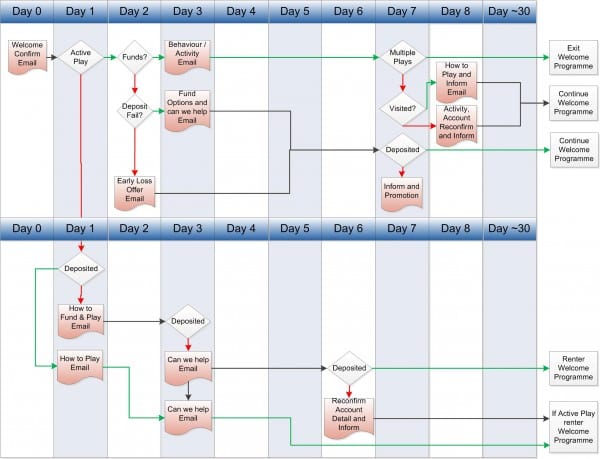Part 3 in a series showing how Big Data can support marketing

In my previous article in this series exploring the application of Big Data to marketing, I looked at how the Volume component of Big Data provides breadth and depth to your understanding of your customers. In this post, I will explore the second of the 3 Vs, the potential impact of Velocity on Marketing.
Let’s first look at what we mean by Velocity and put down a simple definition of ‘Velocity is the speed of data growth/change’.
In the last few years, the accumulation of data has grown at an astonishing rate, with the amount of data increasing by 2.5 exabytes each day or 40% annually at current rates and accelerating.
The big question is, what does velocity mean for businesses looking to tap into it and does this speed of growth/change translate to increased performance and value for marketing? Is it only relevant to big businesses with large IT budgets or can it be applied in small and medium businesses (SMEs).
How does this increase in velocity affect the use of data for marketing?
In a previous post introducing Big Data, I looked at different data types in terms of the content, another aspect is the behaviour of the data in terms of change and growth, which identifies 3 types of data:
- Static Data – This covers data which is unchanged over long periods, such as lookup data. This by its very nature does not have a high velocity, so is not going to be a driver when considering Big Data.
- Dynamic Data – This represents a large portion of your current operational and customer data, which is regularly added to and updated, such as orders. Within this you will have two further sub divisions:
- Change – Data which is updated on a regular basis, such as customer details that will have for example preference & contact, information change on an ongoing basis.
- Growth – Data which grows regularly, such as outbound communication details that will be added to each time a customer is communicated with.
Dynamic Data does have velocity and for some SMEs this is Big Data, if the number of transactions and communication activity is high. For most SMEs this is however, business as usual and can be managed using existing solutions. These first two data types will already exist within your business and be managed to differing levels through batch processes completed weekly or daily, with some systems extending to complete hourly, or even 15-minute updates of key data using drip feeds of changed data only, depending on business needs. The final type of data brings us to real-time or near real-time data, which is continually growing at rates of tens or hundreds of thousands of records per second.
- Continuous Data – With the introduction of Machine Data and Social Data the continued supply of data at a phenomenal rate is a reality, meaning that the pool of data is always growing. This leads to the need to capture, store, analyse and drive insight faster, which is at the essence of Big Velocity in Big Data.
What impact on marketing could continuous data drive?
1) Automation
The continuous growth and change of data provides the opportunity to collect, store and analyse the data to provide responses and next best actions based on current activity/behaviour and not just historic activity/behaviour. To manage this fast moving, ever changing landscape will require automation or teams of 100's to complete the analysis and then drive forward the resultant actions. Automation is the only logical choice and will enable you to provide decisions and responses based on current behaviour, so in context and reflecting the customer’s experience personally not as a group message. If we take Automation as a given to help manage the Velocity of Big Data, what does this enable us to achieve:
- Automated Response Management – Already achievable with existing data, this capability is extended to be across all channels, providing the opportunity to respond to current activity/sentiment/opinion and hence presenting context based messages. For example, during the recent cash machine problems of TSB, Lloyds and Halifax the message and tone could have be altered based on the general social sentiment and if the given customer was active dissenter. In a phrase ‘joined up conversations’.
- Automated Personalisation – As with Volume, Velocity provides the opportunity to know your customer, with the key difference of knowing the customer in the moment not just as a composite view. This will enable greater current personalisation via desktop, mobile and local devices and across ad networks (including Real Time Buying or programmatic ad buying). It will also lead to greater relevance, connection and conversations with your customer.
- Automated Actionable Evaluation – Holistic marketing dashboards have been a common part of the marketing toolkit for many years, providing a way to check KPIs and critical marketing metrics against current and previous levels. With the addition of Big Data techniques, the measured results will also accelerate driving the need to automate the action indicated by the change to the indicator in question (positive or negative). This will enable marketing activities to reflect current performance and ensure the budget (time, resource and money) is allocated effectively.
2) Improved Marketing Performance
The provision of real-time data which can be analysed and compared with other sources, enables a far greater review of how you marketing activities are performing. For example looking at a simplified Welcome Programme, for online gaming customers:

The analysis of customer behaviour could be increased to a granular level to begin understanding the impact of each contact and game activity, in relation to other social and online activities. This would enable improved management of customers within the Welcome Programme and allow more immediate responses to changes in standard behaviour or external factors on customer’s game play. For example, communicating during play to respond to activity and game outcomes, through the appropriate current customer interaction channel to improve the customers experience and length of engagement.
3) Targeting
The delivery of real-time data provides the opportunity to target or conversely not target, based on current knowledge. How many times have you raised hand (figuratively) and been ignored, even when you ask questions such as ‘How much does this cost?’ Too often and usually because of one of two factors:
- No one was listening.
- The person listening didn’t hear you or want to hear you.
Having the ability to store and use data as it is generated will enable you to reduce this impact, through the availability of current activity/behaviour. So when a customer has completed reviews of products, asked questions on social networks and generally provided positive, inquisitive indicators you can then target this customer with appropriate marketing activity. Alternatively, a customer who has complained and raised negative sentiment on social sites requires a different type of communication activity. A good example is the Insurance Industry, where communicating to current customers can initiate customer reviews and increase the attrition rate in some customer groups. Understanding current behaviour across multiple channels can ensure you respond to their activity and not a generalised one size fits all approach, providing the right level of information and recognising that customers may want:
- Detail - Detailed information to make an informed researched decision.
- Ease - Simple and Quick renewal process, saving time.
- Value – Comparison of prices to enforce feeling of receiving a good deal.
- Protection – Confirmation of cover, added extras and customer claim testimonials, to provide piece of mind.
In this second post looking at the value to Marketing of the 3 Vs of Big Data I have looked at how Velocity provides current understanding of your customers, improving marketing performance. In the final post I will look at the impact of Variety.








